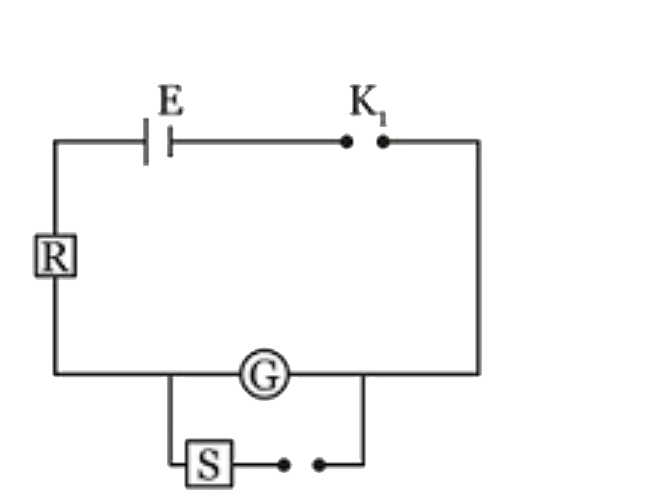In a circuit for finding the resistance of a galvanometer by half deflection method, a 6 V battery and a high resistance of 11 kΩ are used. The figure of merit of the galvanometer is 60 μA/division. In the absence of shunt resistance, the galvanometer produces a deflection of θ=9 divisions when current flows in the circuit. The value of the shunt resistance that can cause the deflection of θ/2, is closet to :
550Ω
220Ω
55Ω
110Ω
The correct Answer is:D
To solve the problem of finding the shunt resistance S that causes the galvanometer to deflect to θ2, we will follow these steps:
Step 1: Calculate the current through the galvanometer without the shunt
The deflection of the galvanometer is given as θ=9 divisions. The figure of merit of the galvanometer is 60μA/division. Therefore, the current Ig through the galvanometer can be calculated as:
Ig=Figure of Merit×Number of Divisions=60μA/division×9divisions=540μA=540×10−6A
Step 2: Determine the total resistance in the circuit
The total voltage V provided by the battery is 6V, and the high resistance RH is 11kΩ (or 11000Ω). The total current I in the circuit can be expressed using Ohm's law:
I=VRH+Rg
Where Rg is the resistance of the galvanometer. We can rearrange this to find Rg:
I=611000+Rg
Setting I=540×10−6A:
540×10−6=611000+Rg
Step 3: Solve for Rg
Cross-multiplying gives:
540×10−6(11000+Rg)=6
Expanding and rearranging:
540×11000×10−6+540×10−6Rg=6
Calculating 540×11000×10−6:
5940×10−3+540×10−6Rg=6
5940×10−3+0.54Rg=6
Now, isolate Rg:
0.54Rg=6−5.94
0.54Rg=0.06
Rg=0.060.54≈0.1111kΩ=111.1Ω
Step 4: Calculate the new current for half deflection
For half deflection, the current through the galvanometer I′g will be:
I′g=Ig2=540μA2=270μA=270×10−6A
Step 5: Find the total current in the circuit with shunt
The total current I in the circuit can be expressed as:
I=VRH+S∥Rg
Where S∥Rg is the equivalent resistance of the shunt and the galvanometer:
1S∥Rg=1S+1Rg
The total current can also be expressed as:
I=I′g+Is
Where Is is the current through the shunt. Since Is=I−I′g, we can write:
I=611000+SRgS+Rg
Step 6: Solve for shunt resistance S
Using the relationship:
I=VRH+S∥Rg
Substituting I′g into the equation and solving for S:
1. Substitute I=270×10−6+Is.
2. Use the equivalent resistance formula for S∥Rg.
3. Solve for S.
After calculations, we find that:
S≈110Ω
Final Answer
The value of the shunt resistance S that can cause the deflection of θ2 is closest to 110Ω.
---
The deflection of the galvanometer is given as θ=9 divisions. The figure of merit of the galvanometer is 60μA/division. Therefore, the current Ig through the galvanometer can be calculated as:
The total voltage V provided by the battery is 6V, and the high resistance RH is 11kΩ (or 11000Ω). The total current I in the circuit can be expressed using Ohm's law:
Cross-multiplying gives:
0.54Rg=0.06
Rg=0.060.54≈0.1111kΩ=111.1Ω
For half deflection, the current through the galvanometer I′g will be:
The total current I in the circuit can be expressed as:
Using the relationship:
2. Use the equivalent resistance formula for S∥Rg.
3. Solve for S.
The value of the shunt resistance S that can cause the deflection of θ2 is closest to 110Ω.
Topper's Solved these Questions
Similar Questions
Knowledge Check
- Question 1 - Select One
The deflection in a galvanometer decreases to 1/5th of the original deflectioon, if it is shunted by a resistance of 5Ω. The resistance of the galvanometer is
A1ΩB10ΩC15ΩD20Ω - Question 2 - Select One
To know the resistance of a galvanometer by half deflection method, a battery of emf V and resistance R is used to deflect the galvanometer by angle θ . If a shunt of resistance is needed to get half deflection then, G, R and S are related by the equation :
A2S(R+G)=RGBS(R+G)=RGC2S=GD2G=S - Question 3 - Select One
To know the resistance G of a galvanometer by half deflection method , a battery of emf VE and resistance R is used to deflect the galvanometer by angle θ . If a shunt of resistance S is needed to get half deflection then , G,R and S related by the equation :
A2S(R+G)=RGBS(R+G)=RGC2S=GD2G=S
In an experiment to determine the resistance of a galvanometer by half deflection method, the circuit shown is used. In one set of readings , if R=10ΩS=4Ω, then the resistance of the galvanometer is
 View Solution
View SolutionWhen a moving coil galvanometer is shunted with a resistance of 10Ω,the deflection in the galvanometer reduces from 30 divisions to 6 divisions. The resistance of the galvanometer is
View SolutionThe deflection of a moving coil galvanometer reduces to half on shunting it with a resistance of 60Ω . The resistance of galvanometer is
View SolutionThe deflection in a moving coil galvanometer falls from 100 divisions to 20 divitation when a shunt of 12Ω is used. The resistance of the galvanometer coilds is
View SolutionA moving coil galvanometer of resistance 100Ω is used as an ammeter using a resistance 0.1Ω. The maximum diflection current in the galvanometer is 100μA. Find the minimum current in the circuit so that the ammeter shows maximum deflection
View Solution


